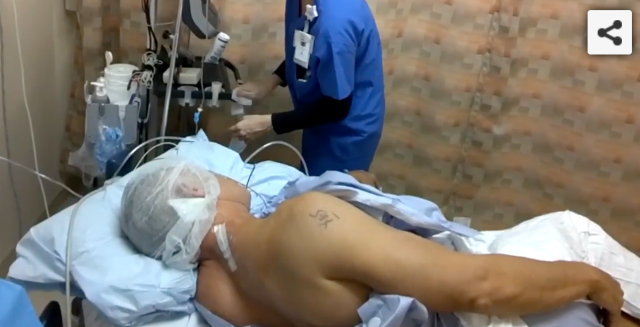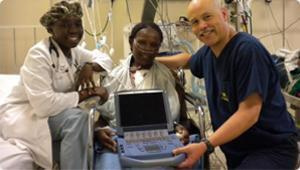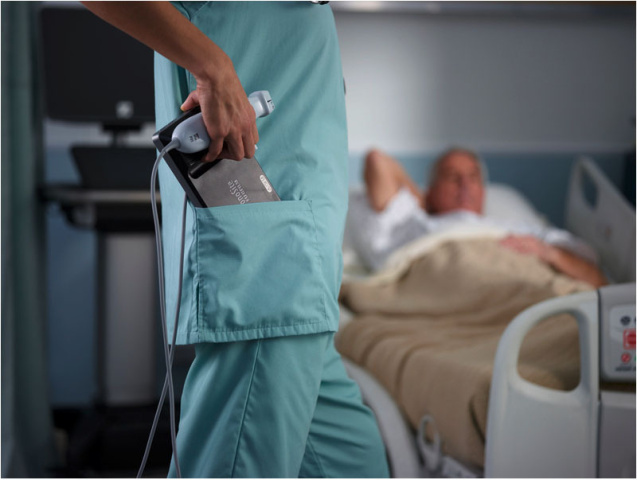Game-Changer
Imaging Economics | September 2011
"Use of ultrasound at the point of care is growing in sports medicine. In office practice and on the playing field, this versatile technology is now widely used by team physicians in professional sports to provide dynamic real-time evaluation and safe, accurate treatment of players' injuries. Most European soccer clubs, as well as the National Basketball Association, are taking advantage of ultrasound's well-established benefits for improving patient safety and outcomes, at a fraction of the cost of MRI or CT scans." Read the full article by Steven Sampson, DO, on the Imaging Economics site. …
Joint Commission and the Risk of Medical Imaging Radiation
The Joint Commission is sending a powerful notice about the radiation risks of diagnostic imaging. Its August 24, 2011, Sentinel Event Alert clearly states that diagnostic radiation can save lives. That is not in dispute. What is at issue is the amount of radiation patients receive over time and the risk for long-term damage.
Over the last 20 years, Americans’ exposure to ionizing radiation has nearly doubled. As the Joint Commission states, “…any physician can order tests involving exposure to radiation at any frequency, with no knowledge of when the last of when the patient was irradiated or how much radiation the patient received.” The World Health Organization’s International Agency for Research on Cancer, the Agency for Toxic Substances and Disease Registry of the Centers for Disease Control and Prevention and the National institute of Environmental Health Sciences all classify x-rays as a carcinogen.
As an Emergency Physician, I recognize the value of x-rays and CT scans and use them when they are medically appropriate. In its Sentinel Event Alert, one of the Joint Commission’s recommended actions is use other imaging modalities when appropriate: “In order to reduce the expose of the patient to ionizing radiation, use other imaging techniques, such as ultrasound or MRI, whenever these tests will produce the required diagnostic information at a similar quality level.” …
Interscalene Catheter with Google Glass by Dr. Brandon Winchester

A cleverly recorded ultrasound-guided interscalene catheter procedure. The block video was made exclusively with the video camera and microphone built into Google Glass. …
Good News about Healthcare Reform

The Good News About Healthcare Reform: Smarter Use of Imaging Technology Helps Reduce Hospital Errors, Healthcare Costs
Paul Sierzenski, MD …
$330 Million Risk: What Boards Should Know

In his article that advises American Hospital Association member trustees, Rodney Hockman, MD warns that hundreds of hospitals are likely to be penalized by Medicare for patient injuries under the Hospital-Acquired Condition (HAC) Reduction Program starting in October 2014. He points out that each penalized hospital stands to lose nearly $434,000 in Medicare reimbursements on average, with large hospital systems and those with a high volume of Medicare payments potentially facing much greater losses should they provide unsafe care.
Dr. Hochman points to institutions using a bundle of best practices to address this, including 353-bed White Memorial Hospital, part of the Adventist Health System in Los Angeles, to eliminate two of the serious complications used to determine penalties under Medicare’s HAC Reduction Program: pneumothorax and central line-associated bloodstream infections (CLABSIs). Both conditions are now included on AHRQ’s list of patient safety indicators. …
Smarter Use of Imaging Technology: Reduce Errors Costs
Medical errors continue to be a major problem in the US healthcare system, with hospital acquired infections (HAC) becoming an area of greater focus and where significant financial penalties are being incurred. Medicare has added one especially dangerous--or even potentially fatal--adverse event, iatrogenic pneumothorax during central line placement, to its HAC list. Along with putting patients in peril, the mistake can also increase hospital costs by up to $45,000 per incident, according to a study by the Agency for Healthcare Quality and Research (AHRQ).
Many excellent studies show that ultrasound guidance can powerfully improve the safety and success of this very common procedure. In fact, in one randomized study of 900 critical care patients, use of ultrasound visualization reduced the rate of collapsed lung during central line placement to zero, compared to 2.4 percent for blind placement.
Dr. Sierzenski is the Director of Emergency, Trauma and Critical Care Ultrasound for Christiana Care Health System’s Department of Emergency Medicine. He is also the Chair, Government Policy & Public Relations for the American College of Emergency Physicians Ultrasound Section and a Master's Candidate in Health Quality and Safety at the Jefferson School of Population Health.
…
$330 Million Risk: What Boards Should Know

In his article that advises American Hospital Association member trustees, Rodney Hockman, MD warns that hundreds of hospitals are likely to be penalized by Medicare for patient injuries under the Hospital-Acquired Condition (HAC) Reduction Program starting in October 2014. He points out that each penalized hospital stands to lose nearly $434,000 in Medicare reimbursements on average, with large hospital systems and those with a high volume of Medicare payments potentially facing much greater losses should they provide unsafe care.
Dr. Hochman points to institutions using a bundle of best practices to address this, including 353-bed White Memorial Hospital, part of the Adventist Health System in Los Angeles, to eliminate two of the serious complications used to determine penalties under Medicare’s HAC Reduction Program: pneumothorax and central line-associated bloodstream infections (CLABSIs). Both conditions are now included on AHRQ’s list of patient safety indicators. …
Smarter Use of Imaging Technology: Reduce Errors Costs
Medical errors continue to be a major problem in the US healthcare system, with hospital acquired infections (HAC) becoming an area of greater focus and where significant financial penalties are being incurred. Medicare has added one especially dangerous--or even potentially fatal--adverse event, iatrogenic pneumothorax during central line placement, to its HAC list. Along with putting patients in peril, the mistake can also increase hospital costs by up to $45,000 per incident, according to a study by the Agency for Healthcare Quality and Research (AHRQ).
Many excellent studies show that ultrasound guidance can powerfully improve the safety and success of this very common procedure. In fact, in one randomized study of 900 critical care patients, use of ultrasound visualization reduced the rate of collapsed lung during central line placement to zero, compared to 2.4 percent for blind placement.
Dr. Sierzenski is the Director of Emergency, Trauma and Critical Care Ultrasound for Christiana Care Health System’s Department of Emergency Medicine. He is also the Chair, Government Policy & Public Relations for the American College of Emergency Physicians Ultrasound Section and a Master's Candidate in Health Quality and Safety at the Jefferson School of Population Health.
…
Final 2016 Medicare Inpatient Rule Contains Provisions to Promote Patient Safety
2015-09-28T07:00:00Final 2016 Medicare Inpatient Rule Contains Provisions to Promote Patient SafetyJill Rathbun
Jill Rathbun of Galileo Consulting, in her continuing contribution to Dot.Med, explains key points for the FY 2016 CMS Inpatient Prospective Payment Final Rule. Ultrasound plays a role in the Hospital Acquired Condition Program and may contribute to lowering complications.Read article …
Ultrasound-Guided Procedures: Financial and Safety Benefits
ICU ManagementDiku Mandavia, MD, FACEP, FRCPC, Chief Medical Officer at Sonosite, and clinical associate professor of emergency medicine at the University of Southern CaliforniaDr. Mandavia discusses how ultrasound guidance adds value to both patient safety and removing costs from healthcare delivery.Read article …
An Active September in the Nation's Capital
DOT.MedJill RathbunContinuing in a series of Federal policy updates, Jill Rathbun of Galileo Consulting provides the latest news on imaging policy and payments.
Read article …
Reduce Iatrogenic pneumothorax
.fbox {
display: flex;
flex-direction: row;
flex-wrap: nowrap;
justify-content: space-evenly;
align-items: flex-start;
align-content: centre;
}
…
AIUM Recognizes ACEP's Emergency Ultrasound Guidelines
While not all portable ultrasound examinations are of an emergency nature, its predominant use originated within the “we-need-it-STAT” category. Hence, the significant role of emergency medicine in contributing to point-of-care ultrasound best practices and insight into the valuable role ultrasonography can play at the bedside.
In mid-November, the contributions of emergency physicians to the proper use of “focused emergency ultrasound examinations” (a.k.a. point-of-care ultrasound) was acknowledged by the American Institute of Ultrasound in Medicine (AIUM). According to their November 17, 2011,
press release, the AIUM now recognizes the American College of Emergency Physician’s (ACEP) Policy Statement
Emergency Ultrasound Guidelines as “meeting the qualifications for performing ultrasound in the emergency settings. These guidelines describe the education and training required by emergency physicians to achieve competency for the performance of focused emergency ultrasound applications in clinical practice.”
…
A Big Thank-You From Tenwek, Kenya

This story reminds us yet again how lives can be saved when dedicated teamwork combines with progressive medical technology.
…
ASA “Practise Guidelines for Central Venous Access” Published
It may be an exaggeration to suggest that every other month a new guideline or requirement is released by a professional medical body recommending or directing that ultrasound—especially bedside (a.k.a., point-of-care) ultrasound—be incorporated into clinical best practices, but often it feels like it.
Case in point: In my last CMO Corner, I commented on the AIUM recognizing the American College of Emergency Physician’s Policy Statement “Emergency Ultrasound Guidelines,” which acknowledged point-of-care ultrasound as part of emergency care’s best practices.
Not long ago, new ACGME Program Requirements for Graduate Medical Education in Pulmonary Disease and Critical Care Medicine directed that instructors include the teaching of specific bedside ultrasound techniques to graduate students. (By the way, Sonosite is offering equipment and training to help educators meet the requirements that go into effect July 1, 2012.)
…
Studies Indicate CT Scan Overuse, Radiation Overexposure
Recently the medical literature has documented the growing use of CT scans. It is certainly no secret that, when circumstances warrant, Sonosite advocates for the consideration of ultrasound first over other imaging modalities. A CT scan is a powerful and valuable test when used appropriately and—as with all medical procedures—when its therapeutic value is carefully weighed against its potential harm. Yet, while acknowledging CT’s value, I can’t ignore mounting evidence indicating CT scans are being ordered more often than are necessary or safe. …
Morocco Trial Shows Remote Ultrasound Can Expand Access and Improve Maternal Care.
In the remote reaches of rural areas and developing countries there is continuous demand to accessible solutions that provide reliable, faster, and affordable clinical care. Every day, around the world, approximately 800 women die from preventable causes related to pregnancy and childbirth. Of those deaths, 40 percent are due to injuries or conditions related to placenta complications. The only way to detect abnormal placenta challenges is through an ultrasound exam. …
Ultrasound Can Diagnose and Prevent Pneumothorax
I find it ironic that one of the most efficient ways to detect pneumothorax in patients is also one of the most effective ways to prevent two of its more common clinical causes.
While scenarios that might trigger the suspicion of pneumothorax are too numerous to list, screening for it has included the standard trinity of chest-imaging procedures: x-rays, tomography, and ultrasound. In “Think Ultrasound When Evaluating for Pneumothorax” (featured in AIUM’s Journal of Ultrasound in Medicine), author Vicki E. Noble, MD, of Massachusetts General, proposes that ultrasound is the ideal screening modality due to its portability and lack of “risk associated with repeated measures as clinical scenarios change.”
Dr. Noble’s article goes on to provide instruction for performing the examination, incorporates excellent research citations, and then concludes: “Using thoracic sonography as a screening tool may lead to decreased ordering of chest radiographs, thus saving time and money and improving the efficiency of treatment.”
It may come as no surprise that my colleagues and I at Sonosite enthusiastically support Dr. Noble’s conclusion. The entire article—a part of AIUM’s “think ultrasound first” Sound Judgment Series—is available here and is worth a thorough read. …
Memorial Hermann
A Success StorySee why Memorial Hermann's physicians prefer driving with total vision, then find out how we can help …
Trice Imageing, Inc. and FUJIFILM Sonosite Announce iViz Portable Ultrasound Device Integration at Health 2.0

Trice Imageing, a leading provider in the medical image management industry, announced today at Health 2.0 the integration of Tricefy into FUJIFILM Sonosite’s latest portable ultrasound device. …

